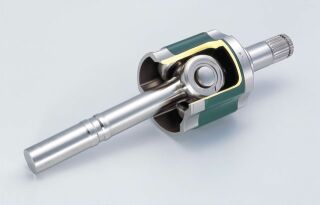Sharp Increase in Orders Received for “PTJ” Ultra-Low Vibration Joint
Year after year, the demands on automobiles are becoming more sophisticated: improved fuel economy, reduction in materials that place a burden on the environment, improved safety, and the pursuit for better ride and comfort. For ride and comfort, the level required by automobile manufacturers is steadily rising, not only for luxury cars, but for also for standard passenger cars and SUVs. For this reason, suppressing even the mildest vibrations during idling and minimizing shudder during acceleration is becoming an important element in vehicle development.
In response to the market need for lighter weight constant-velocity joints with reduced vibration characteristics, NTN Corporation has developed the breakthrough ultra-low vibration “PTJ” constant-velocity joint. This ultra-low vibration constant-velocity joint has the following characteristics:
- Reduced “induced cyclic axial load” and “plunging resistance”, which indicate vibration characteristics; both are reduced by 50% when compared to current low-vibration constant-velocity joints.
- Weight reductions of approximately 20% compared to current designs are attained through reduction in the number of parts, conversion of the contour shape of the outer race to a tulip-like shape, along with several other improvements.
In developing this “PTJ”, NTN used the finite element method (FEM) and numerical analysis to pursue the optimum design. In order to elucidate the low-vibration mechanism, NTN used the ADAMS dynamics analysis software to analyze the mechanism. This ADAMS analysis was then compared with experimental results to verify the theoretical understanding of the low vibration characteristics.
In the NVH (noise, vibration, harshness) evaluation testing carried out by automobile manufacturers on actual vehicles, the “PTJ” received the highest grades for its low vibration characteristics. Delivery for mass- production began at the end of last year for Japanese and Foreign Auto Manufactures. In addition many other orders have poured in on a global scale for various other potential customers. Sales of driveshafts using the “PTJ” are forecast to reach JPY6 billion in Fiscal Year 2003 and JPY15 billion in Fiscal Year 2005.
With automobile manufacturers pursuing improvements in ride comfort and cabin noise, the demand for the “PTJ” is expected to increase, especially for luxury passenger cars and SUVs.

|
